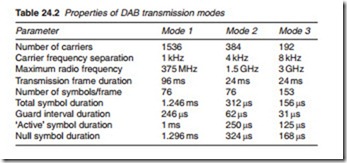Compatibility
DVB-H is fully compatible with DVB-T. It can be used in 6, 7 and 8 MHz channel environments. However, a 5 MHz option is also specified for use in non-broadcast environments. A key initial requirement, and an amaz- ing feature of DVB-H, is that it can co-exist with DVB-T in the same mul- tiplex. Thus, an operator can choose to have 2 DVB-T services and one DVB-H service in the same overall DVB-T multiplex.
Introduction to DAB
DAB was developed in the early 1990s by the European consortium Eureka 147, mainly to replace the widely used analogue frequency mod- ulation (FM) broadcasting system. The VHF band is a scarce resource in many parts of the world, so there was a need for a spectrally more effi- cient modulation method than FM. In DAB, this is achieved by multi- plexing several programmes into a so-called ensemble with a bandwidth of 1.536 MHz, where the number of programmes per ensemble is flexi- ble and depends on individual programme bandwidth requirements. Further, conventional analogue techniques do not provide satisfactory performance in a mobile environment, because they are highly affected by multi-path propagation and thus fading. In DAB, orthogonal fre- quency division multiplex (OFDM) has been chosen to overcome the effects of multi-path propagation, enabling the system to operate in SFNs. DAB is designed to operate in any frequency band in the VHF and UHF range for terrestrial, satellite, hybrid (satellite with complementary ter- restrial) and cable delivery.
DAB is a spectrum-efficient rugged system, not dissimilar to the digital terrestrial TV broadcasting in that the stereophonic audio is digitised, com- pressed and modulated using OFDM. Audio programme information is incorporated as a digital bitstream, with the system supporting a wide range of options for other data, either associated with or independent from the sound programmes. Compression is performed using MPEG-1 layers I, II or III described in Chapter 6. The encoder can operate in stereo or mono mode and the output bit-rate is selectable between 384 kb/s, for a stereo signal, down to 32 kb/s for a mono signal, with a corresponding reduction in the quality of the re-constructed audio signal. A value of 256 kbps has been judged to provide a high-quality stereo broadcast signal. However, a
small reduction, to 224 kbps is often found acceptable, and in some cases it may be possible to accept a further reduction to 192 kb/s, especially if redundancy in the stereo signal is exploited by a process of ‘joint-stereo’ encoding (i.e. some sounds appearing at the centre of the stereo image need not be sent twice). At 192 kb/s, it is relatively easy to hear imperfections in critical audio material.
The DAB broadcasting system (Figure 24.4) is not dissimilar than the DVB described in Chapter 8. The audio signal is MPEG layer-2 encoded and then scrambled. FEC is applied to the scrambled bitstream by employ- ing punctured convolutional codes with code-rates ranging from 0.25 to 0.89. The bitstream is sent through a time interleaver before it is multi- plexed with the other programmes to form an ensemble. The ensemble bit- stream is then used to modulate the OFDM carriers using differential QPSK. To achieve orthogonality, the sub-carriers are spaced in frequency by the inverse of the symbol duration, theoretically resulting in zero inter- carrier interference. The relatively high ensemble bandwidth of 1.536 MHz gives good frequency diversity, since frequencies are not affected in the same way by fading. Adjacent bits within the MPEG bit-stream are made statistically independent with respect to bit errors by employing fre- quency and time interleaving, leading to good performance of the convo- lutional decoder (Viterbi) at the receiving end.

